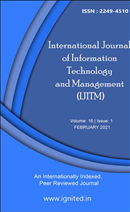Role of the Human Resource Management in Team Building
Main Article Content
Authors
Abstract
Each team must deal with the full range of issues that might develop during any type oforganizational change. For instance, when employees are paired with a stranger they have never metbefore, tensions may arise. One of the unintended consequences of establishing new teams is tearing apartfriends who used to work together. An approach that might be employed to cope with this issue isteamwork. An organization's efficiency, and especially its ability to make choices, might be compromisedby the sheer number of challenges it faces. If the team doesn't already have any goals in mind, it's criticalthat they be established. Without enough training and preparation, it can be difficult for groups todetermine and pursue a shared goal. Other potential sources of tension include ineffectivecommunication, internal conflicts, and an overemphasis on the necessity for compromise in socialrelationships.
Downloads
Download data is not yet available.
Article Details
Section
Articles
References
- Anil Kumar Singh, HRD Practices & Organization Culture in India, Indian Journal of Industrial Relations, Vol. 45, No. 2 (October 2009), pp. 243- 254
- Beich, E. (Ed.). (2001). The Pfeiffer book of successful team-building tools. San Francisco, CA: Jossey-Bass/Pfeiffer.
- Board, L. M. (2007). Coaching a stockholder on performance improvement option, ASTD International conference Bowen RB.Recognizing and Rewarding Employees. New York: McGraw-Hill, 2000.
- Branham, L. (2005). Planning to become an employer of choice. Journal of Organizational Excellence, 24, 3, 57-68.
- Dave Ulrich, 2012 (Dave Ulrich delivers a keynote address, “The future of HR – creating value from the outside in”, on 21 November 2012 at the HR Performance conference and exhibition at Excel, London), “What‟s next for HR? The six competencies HR needs for today‟s challenges”.
- Fong, P., and Lung, B. (2007). "Inter organizational teamwork in the construction industry." Of Construction Engineering and Management, 133(2), 157.
- Glen, C. (2006). Key skills retention and motivation: The war for talent still rages and retention is the high ground. Industrial and Commercial Training, 38, 1, 37-46.
- Michie, J., & M. Sheehan. 2005. “Business Strategy, Human Resources, Labor Market Flexibility and Competitive Advantage,” International Journal of Human Resource Management 16(3), 445-464.
- Dianna (2006) Teams: Teamwork and Teambuilding, Prentice-Hall, New York.
- Edger, E. H. and Thomas G. C. (1985). Organization Development and Change, West Publishing Company, St. Paul; New York.
- Fajana S. (2002) Human Resources Management: An Introductory, Labofin and Company, Lagos
- Heliriegel, S. W. (1986). Instructor's Resource Guide to Accompany Organizational Behavior 4th edition. West Publishing Company.
- LaFasto, Frank M. J.; Larson, Carl (August 2001). When Teams Work Best. Thousand Oaks, CA: Sage.
- Robbins, S.P. 1998, Organizational Behaviour: Concepts, Controversies, Applications, Prentice-Hall, New York.

